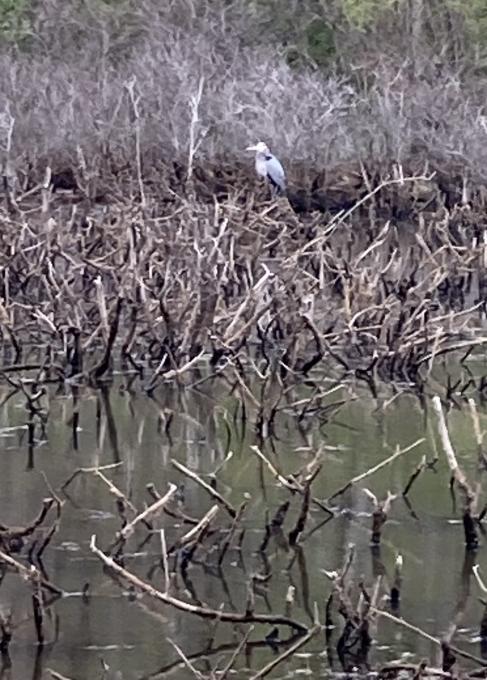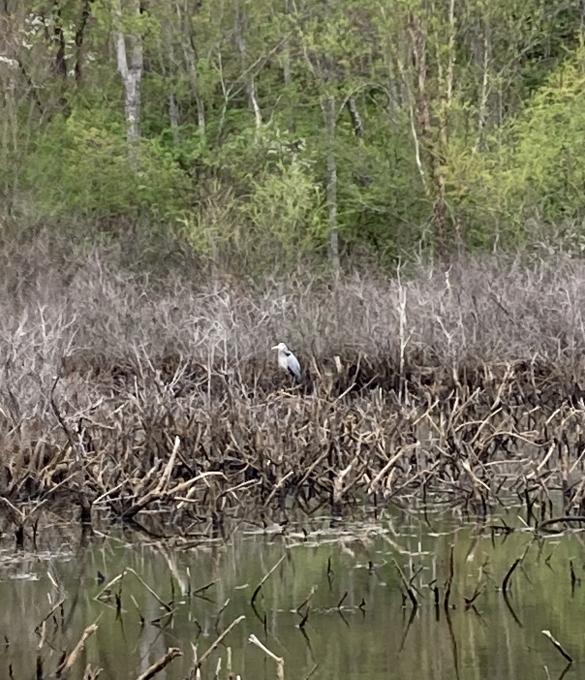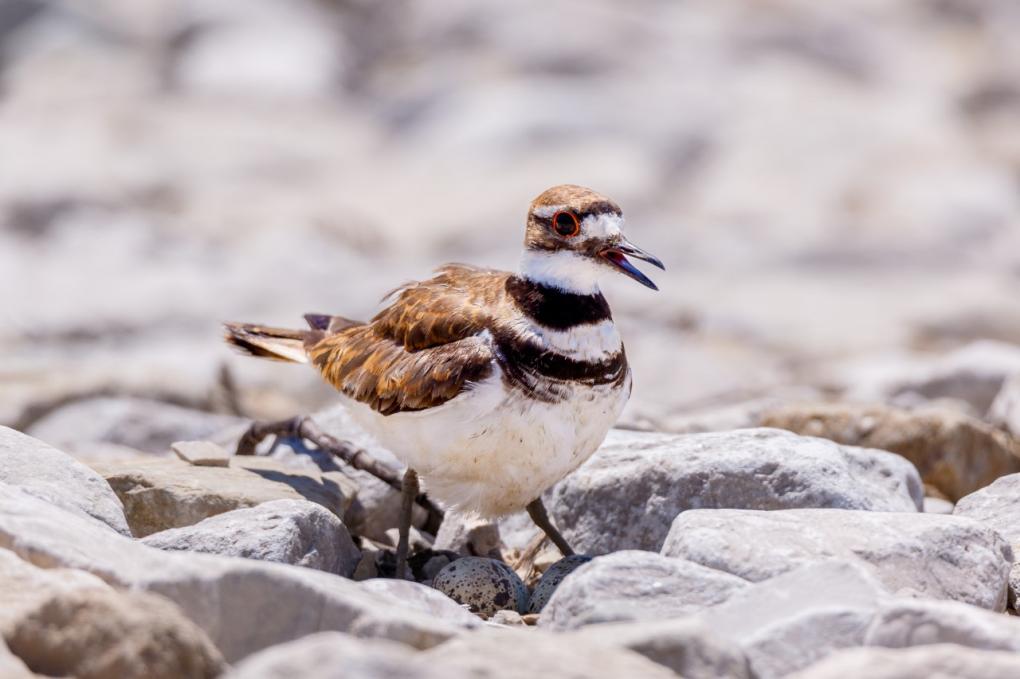The Cornell Lab Bird Academy › Discussion Groups › Joy of Birdwatching › Activities: Exploring Bird Habitats
-
Activity 1: The nearby park has a lagoon with a patchy, relatively young forest on one side and a small meadow on the other. The forest is frequented by warblers, vireos, American robins, Baltimore orioles, and gray catbirds; woodpeckers and hummingbirds can sometimes also be seen. The meadow is a better place to find red-winged blackbirds, European starlings, and occasionally Cooper's hawks. Of course, the lagoon itself has plenty of ducks and geese, as well as herons, egrets, gulls, terns, and double-crested cormorants.
Activity 2: Down House hosts many kinds of doves, gulls, and songbirds, along with some raptors, pheasants, and woodpeckers. In contrast, Sevenoaks hosts many kinds of ducks, geese, and wading birds, as well as some swallows. There is reasonable overlap between the species lists, and both seem to host several kinds of corvids. From this, I imagine that Down House has a lot of open spaces with some wooded groves, while Sevenoaks has some extensive aquatic habitats, perhaps a small wetland bordered by trees. -
my favourate place to go birding is a mixed forest with a relatively dense shrub life and a nearby slough. We get too see many different types of birds here due to the wildlife trees standing in the forest supplying food for the woodpeckers and many other birds whome like to eat insects. There is a nearby eagle nest that gets used yearly and I even got the opportunity to see a juvenile spend time with its parents sqeeing over and over for attention or maybe food (I didnt have my binoculars with me when that happened :crying emoji:) the second spot I had in mind is a nearby hotspot on the other side of a mountain I live near. The expected birds there are quite different from here as they have a freshwater lake and a relatively old forest as well however there are a large amount of tourists in the area during the summer as there are resorts along the lake side. This causes many types of generalist birds to congregate and feed on the garbage that is left from these people coming through.
-
My favorite place to see birds is in the Atchafalaya Basin not far from Houma, LA. I started going there 10 years ago in April to see the eagles. Before then, I had no idea there was such a large population of eagles in the area. Going in the end of April-beginning of May is a good time to see eaglets. I have seen many other birds there including herons, egrets, ibisis, spoonbills, roseate spoonbills, cormorants and more. Different species appear at different times of year but if you’re interested in eagles the best time to go is late April to early May. We travel with a nice Cajun guy and he knows exactly where to find the birds. Of course, you will also see alligators during the tour.
-
Activity 1 - The two locations close to me are the Consumnes River Preserve which is California's largest remaining Valley Oak reparian forest and one of the few protected wetland habitat area in the state. The second location is Lodi Lake in Lodi CA.
The first Preserve is beautiful and has a forest, aquatic, scrub-shrub and open habitats. In the forest, I have seen hummingbirds fanning their wings sipping flower juices and woodpeckers pounding against trees. The pound of thre or four on different trees made such wonderful sounds like tree drums. In the aquatic area, the Egrets dance together and search for food, swamp sparrows flit and land on lovely willows. Scrub-shrub habitat raptors swoop in for a snake or a rat while turkeys, wrens and sparrows skitter about get their bugs. In the open habitat there were sparrows and larks were playing chase for fun (that is what it looked like).
The Lake has a small forest, aquatic and open picnic area. On the 3rd of July, I saw a graceful egret fly away from the lake. The Canada Geese were enjoying a bundle of roots along the lake edge. Sweet swallows were eating bugs. Many of the animals started hiding because a big BBQ.
Activity 2 - Mt. Lemmon appears to have a forest and open regions on the Hot spot map. The most recent birds were the American Robin, Blue Jays, Woodpecker (White Breasted), White winged dove, and a Great Horned Owl. Seven Oaks WR & SSSI in Kent County seems to have an aquatic habitat according to the Hot spot map. The check list had Northern Lapwing, Egyptian Goose and Long Tailed Tit with pictures. The last visit by birders were in April.
Ruth Bates -
Activity 2: When reviewing the Roger Road and Mt. Lemmon ebird hotspots I noticed that Roger Road attracts Northern Shoveler, various ducks including Mallard and Ruddy and herons such as the Great Blue Heron and Black Crowned Night Heron. This indicates a wetland habitat.
Mt. Lemon is more mountainous and therefore the home to hawks and owls who can soar higher and nest far above other species such as those visiting Roger Road.
Both habitats attract far more species than I expected to find in one area.
-
location were a local wetlands area and a tree lined country road near open fields.
At the wetlands this week I was able to spot a wading bird. I used the bird identify questions and am pretty sure it was a female blue heron. She was not as tall as expected but using binoculars I thought perhaps she was sitting on a nest. I took a couple of picture but they are from a distance. I will post them below. I read that some herons nest in trees and some in the marshy area if they feel it is safe. This heron was the only bird I saw that evening. In the past we have seen ducks and geese in these wetlands but not this time.
On my country walk one afternoon this week I spotted red-winged black birds in the field, northern cardinals in the trees and many of Purple Martins at a Martin house our Amish neighbors installed.
These are two of the different habitats in my local area.


-
Activity 1: My first birding spot is a nearby dam and the river that flows from it. I have seen osprey, cormorants, Canada geese, great Blue Herons, and even Bald Eagles. The edges of the river are forested which have many of the songbirds common to the area. My second birding spot is a nearby park that has a small pond where I have seen Canada geese and Great blue Herons but no Ospreys, cormorants or Bald Eagles. Some edges of the park are forested and have the same songbirds as the dam area. The park also has a large field area where I have seen Killdeer which I have never seen in the dam area.
Activity 2: I looked at the bird list of Roger Road and Mt. Lemmon. Roger Road has a lot of birds you would find near water such as ducks, cormorants and egrets. I'm guessing that there is a large pond or lake there. Mt. Lemmon must have trees there since a lot of the listed birds, such as woodpeckers and warblers live in tree habitats. -
Activity #1: My first birding spot is a second growth young mixed deciduous forest in Eastern Ontario. I see lots of woodpeckers. We have downy woodpeckers, hairy woodpeckers, red bellied woodpeckers, norther flickers and pileated woodpeckers.
My second birding spot is a wet land surrounded by old growth mixed forest with lots of birds that I'm not familiar with yet. I do hear lots of Canada Geese and red-winged blackbirds there. -
Activity 2: For this prompt, I explored the species found at two different eBird hotspots in Arizona: Roger Road and Mt. Lemmon. Based on the waterfowl and birds found at Roger Road, I would say that this habitat is aquatic - perhaps a marsh or lake. Based on the raptors and songbirds found at Mt. Lemmon I would guess that the habitat is more forested.
-
I live in a rural and heavily wooded area in northern New Hampshire, In the warmer months, we see a lot of woodpeckers, hummingbirds, wrens, cardinals, crows, ravens, etc. Right now, in January, it is hard to find birds. I have heard blue jays, though. A second area would be by Moore Dam near me - I would expect to see ducks and herons.
-
In my yard, which is a suburban area west of Phoenix (Sonoran Desert). In my yard I have witnessed a variety of common birds including hummingbirds, who feed from my agave flower in the spring and summer, gambles quail, who nest in my rosemary bush, and all manner of pigeons or doves, primarily rock pigeons and mourning doves.
Going into the city of Phoenix, the variety is less noticeable, though on occasion some pigeons and cardinals have been located, along with the more uncommon roadrunner sighting. It's estimated that 1 acre of land in the Sonoran desert is lost every hour due to construction within Phoenix's city sprawl. The Phoenix metro area is growing rapidly, and as a result the wildlife is being affected too. -
I live in south texas near Houston. There are many hotspots with rivers, lakes and piney woods. Then with a short drive you can be at the Gulf of Mexico and watch all the shorebirds.
-
#1. Participated in an annual bird count at an animal sanctuary in Maryland. Around and on the pond were dozens of Canada geese and mallards, with some wigeons, shovelers, and blue-winged teals. We spotted a few bald eagles and vultures over the open fields. The woods featured woodpeckers (downy, red-bellied, and red-headed) and nuthatches on the trees, sparrows and wrens in the understory, and even some ruby-crowned kinglets flitting around, among other species.
-
Puger Sound bird watching in fall and witer bring 2 species of Cormorants, Horned and Pied Bill Grebes, Murres, Pigeon Guillemots, Harlequins, Buffleheads, Surf Scoters, Hooded Mergansers. Salish Sea sughtings, OysterCatchers, Pelicans, Puffins, and many species of gulls
-
Nature Preserves along Lake Washington (Juanita Bay Kirkland WA) and (Union Bay Nature Preserve Seattle, WA) American Coots, Wood Ducks, Mandarin Duck, Gadwalls, Grebes, American Wigeons, Northern Shovelers, Double Rested Cormorants, Wilsons Snipes (in reeds), Killdeer (mudflats) , great Blue Herons, Green Herons, American Eagles, Red-winged Blackbirds (reeds/ cattails), Owls (wooded areas), Green Winged Teal, Scoups, and sandpipers.
-
Activity 1 When I went to The river I seen many Double-crested Cormorants and quite a few Ring-bill Gulls also some Common Merganser. At the forest spot there were mostly Black cap Chickadee also seen White-crown sparrow and a few American Goldfinch
-
Activity 1 At a conservation area on the north shore of Lake Ontario. Found in the wooded area are numerous chickideas, that will feed from your hand. Also blue jays, numerous sparrows, and wild turkeys. Other species are present dependent on the time of year.
A second area is a marsh with open water. Here ducks, primarily mallards, swans and geese are usually present. -
I’ve had so much fun 🤩
-
Activity 1: In the heart of the city around our building we’ve seen Killdeer… which is strange spotting a bird that has the movements/body of a shorebird hours away from the ocean. We’ve noticed that it loves the gravel areas around our apartment building as well as the reservoir outside of the building that fills with water during heavy rains. At a nearby nature preserve we would never see these, but we’ve spotted Mallards, Wood Ducks, Herons and Kingfisher.
-
I've noticed the same thing. They seem to spend more time in gravel and rocks than on shores. Here is a Killdeer I found over her eggs, on rocks with rocks going on infinitely in the background. Its fascinating how all of these other birds spend so much time making nice soft, hidden nests and then a mommy-to-be Killdeer sees a gravel parking lot and thinks "Perfect."

-
-
I had fun
-
Activity One: We live in the Adirondack Mountains. The main habitats are woods and water. The woods are primarily songbirds (and turkeys!--just saw some tiny babies a few days ago) and water for us means lakes and ponds. There you see lots of water fowl like loons, mallards, swans, geese etc..
Activity Two: We agree with all that has been written. Big takeaway for us was the number of completed checklists in Arizona compared to England, esp central London. Arizona wins! -
2. A comparison of the bird species at the two sites in Arizona suggests that Roger Road has more water (coots, herons, mallards, ducks) than Mt. Lemmon, which presumably has higher altitudes for hawks, owls and falcons. Both clearly have varied habitats and therefore large numbers of varied species (Roger Road: 257 listed!; Mt. Lemmon: 128), though Roger Road wins out easily in numbers. Both list flycatchers,swallows, woodpeckers, hummingbirds, warblers, buntings, sparrows, orioles so either there is some overlap ecologically or these species adapt to different environments.
-
Totally agree with you! I noticed the same. And I personally feel happy because I was able to imagine those two places by just looking at the birds lists, before doing a research about each of the places.
-
-
Activity 2:
Down House: Birds present in towns and buildings such as different kind of pigeons. There are birds that live in open habitats with some woods as farmland such as hawks, kestrels, and woodpeckers. Also there are birds that are present in aquatic habitats as different kinds of gulls.
Sevenoaks: Most of the birds are present in aquatic habitats like swamps, marshes, ponds and lakes.-
The first thing I noticed, too, was that at Sevenoaks there were more aquatic birds. I'm glad other people noticed what I noticed!
-
-
Activity 1: Dora Kelley Nature Park in Alexandria, VA: I can identify at least two habitats where different kind of birds live, a deciduous forest where I identify at least three local species sharing the habitat: Carolina Chickadee, Tufted Titmouse, and White-breasted Nuthatch. Another species that breeds in this area in the summer share this habitat: Acadian Flycatcher. All of them eat insects, but the Acadian Flycatcher catches them in flight. The three local birds eat seed in addition to insects and share the trunks of trees when foraging. In the same park there is another habitat, a river where I usually see at least two species: Mallards, that are omnivore and dabble to feed, and Great Blue Herons, that eat fish and wade slowly or stand still, peering into the water for prey.
-
I am fortunate to live in a neighborhood that has multiple habitats on my daily walk. As I walk down the street past the homes I can count on Northern Mockingbirds, Mourning Doves, Common Grackles and occasionally Northern Cardinals. When I get to the wooded path there is a pond that has Common Gallinule, Anhinga, Mottled Ducks and often Sandhill Cranes (especially for nesting). A little later I walk past a small lake that will haven Great Blue Herons, Great Egrets, more Mottled Ducks and occasionally Limpkin. Finally, we have a sandy scrub habitat that has a family of Florida Scrub-Jays, Red-bellied Woodpeckers and Blue Jays. Some days on my walk I'll only see about a dozen species and other days there will be nearly 30.
Read More:


